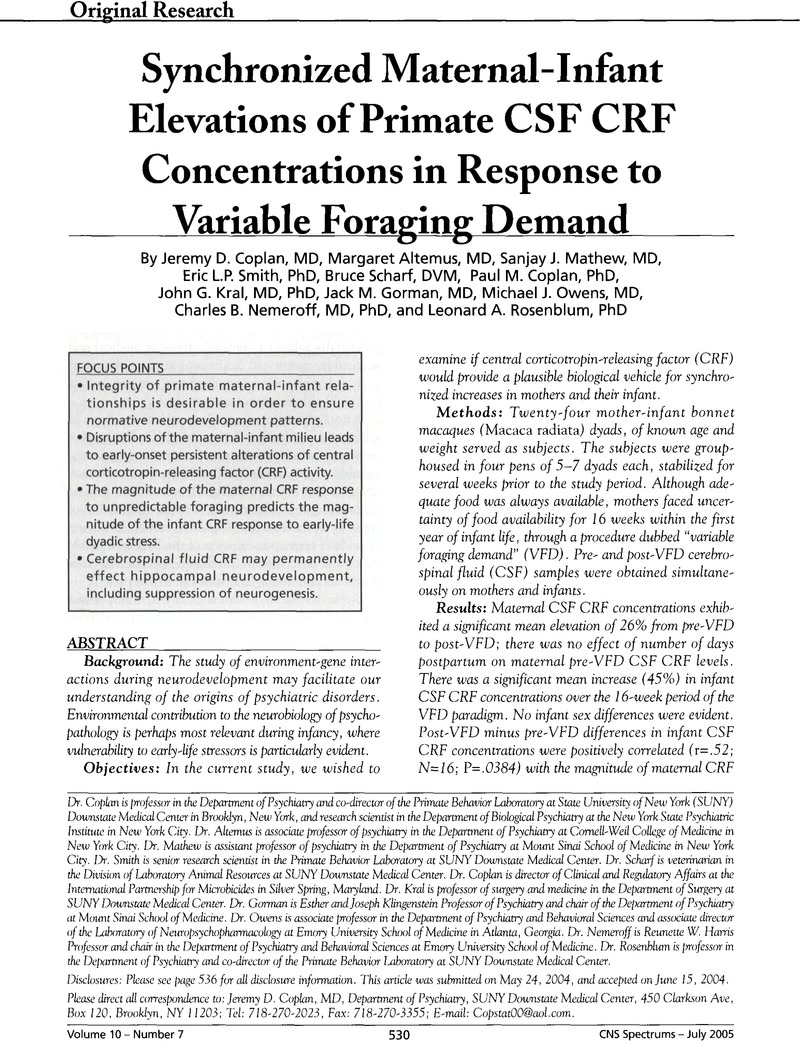Crossref Citations
This article has been cited by the following publications. This list is generated based on data provided by Crossref.
Wallace, Rodrick
2005.
A Global Workspace perspective on mental disorders.
Theoretical Biology and Medical Modelling,
Vol. 2,
Issue. 1,
Ginsberg, J. P.
Ayres, E. D.
Burriss, L. B.
and
Powell, D. A.
2006.
A Study of the Association between Retrospective Appraisal of Childhood Reactivity and Post-Discharge Traumatic Stress in Combat Veterans..
Traumatology,
Vol. 12,
Issue. 1,
p.
61.
COPLAN, JEREMY D.
SMITH, ERIC L.P.
ALTEMUS, MARGARET
MATHEW, SANJAY J.
PERERA, TARIQUE
KRAL, JOHN G.
GORMAN, JACK M.
OWENS, MICHAEL J.
NEMEROFF, CHARLES B.
and
ROSENBLUM, LEONARD A.
2006.
Maternal–Infant Response to Variable Foraging Demand in Nonhuman Primates.
Annals of the New York Academy of Sciences,
Vol. 1071,
Issue. 1,
p.
525.
Whitaker, Robert C.
Phillips, Shannon M.
and
Orzol, Sean M.
2006.
Food Insecurity and the Risks of Depression and Anxiety in Mothers and Behavior Problems in their Preschool-Aged Children.
Pediatrics,
Vol. 118,
Issue. 3,
p.
e859.
Cooper, Nicole S.
Feder, Adriana
Southwick, Steven M.
and
Charney, Dennis S.
2007.
Adolescent Psychopathology and the Developing Brain.
p.
347.
Wallace, Rodrick M
Fullilove, Mindy T
Fullilove, Robert E
and
Wallace, Deborah N
2007.
Collective consciousness and its pathologies: Understanding the failure of AIDS control and treatment in the United States.
Theoretical Biology and Medical Modelling,
Vol. 4,
Issue. 1,
Kaffman, Arie
and
Meaney, Michael J.
2007.
Neurodevelopmental sequelae of postnatal maternal care in rodents: clinical and research implications of molecular insights.
Journal of Child Psychology and Psychiatry,
Vol. 48,
Issue. 3-4,
p.
224.
Léonhardt, Marion
Matthews, Stephen G.
Meaney, Michael J.
and
Walker, Claire-Dominique
2007.
Psychological stressors as a model of maternal adversity: Diurnal modulation of corticosterone responses and changes in maternal behavior.
Hormones and Behavior,
Vol. 51,
Issue. 1,
p.
77.
2008.
Collective Consciousness and its Discontents.
p.
185.
Dunlop, Boadie W.
and
Nemeroff, Charles B.
2009.
Handbook of Neuroscience for the Behavioral Sciences.
Coplan, J.D.
Kral, J.G.
Smith, E.L.P.
and
Rosenblum, L.A.
2009.
Encyclopedia of Neuroscience.
p.
981.
Champagne, Frances A.
and
Curley, James P.
2009.
Epigenetic mechanisms mediating the long-term effects of maternal care on development.
Neuroscience & Biobehavioral Reviews,
Vol. 33,
Issue. 4,
p.
593.
Stevens, Hanna E.
Leckman, James F.
Coplan, Jeremy D.
and
Suomi, Stephen J.
2009.
Risk and Resilience: Early Manipulation of Macaque Social Experience and Persistent Behavioral and Neurophysiological Outcomes.
Journal of the American Academy of Child & Adolescent Psychiatry,
Vol. 48,
Issue. 2,
p.
114.
Schmeets, Marcel
and
van Reekum, Ariëtte
2009.
Handboek persoonlijkheidspathologie.
p.
21.
Coplan, Jeremy D.
Abdallah, Chadi G.
Tang, Cheuk Y.
Mathew, Sanjay J.
Martinez, Jose
Hof, Patrick R.
Smith, Eric L.P.
Dwork, Andrew J.
Perera, Tarique D.
Pantol, Gustavo
Carpenter, David
Rosenblum, Leonard A.
Shungu, Dikoma C.
Gelernter, Joel
Kaffman, Arie
Jackowski, Andrea
Kaufman, Joan
and
Gorman, Jack M.
2010.
The role of early life stress in development of the anterior limb of the internal capsule in nonhuman primates.
Neuroscience Letters,
Vol. 480,
Issue. 2,
p.
93.
Ivorra, Jose Luis
Sanjuan, Julio
Jover, Manuel
Carot, Jose Miguel
Frutos, Rosa de
and
Molto, Maria Dolores
2010.
Gene-Environment Interaction of Child Temperament.
Journal of Developmental & Behavioral Pediatrics,
Vol. 31,
Issue. 7,
p.
545.
Wallace, Rodrick
and
Wallace, Deborah
2010.
Gene Expression and Its Discontents.
p.
201.
Coplan, Jeremy D.
Mathew, Sanjay J.
Abdallah, Chadi G.
Mao, Xiangling
Kral, John G.
Smith, Eric L.P.
Rosenblum, Leonard A.
Perera, Tarique D.
Dwork, Andrew J.
Hof, Patrick R.
Gorman, Jack M.
and
Shungu, Dikoma C.
2010.
Early-life stress and neurometabolites of the hippocampus.
Brain Research,
Vol. 1358,
Issue. ,
p.
191.
Jackowski, Andrea
Perera, Tarique D.
Abdallah, Chadi G.
Garrido, Griselda
Tang, Cheuk Y.
Martinez, Jose
Mathew, Sanjay J.
Gorman, Jack M.
Rosenblum, Leonard A.
Smith, Eric L.P.
Dwork, Andrew J.
Shungu, Dikoma C.
Kaffman, Arie
Gelernter, Joel
Coplan, Jeremy D.
and
Kaufman, Joan
2011.
Early-life stress, corpus callosum development, hippocampal volumetrics, and anxious behavior in male nonhuman primates.
Psychiatry Research: Neuroimaging,
Vol. 192,
Issue. 1,
p.
37.
Coplan, Jeremy D.
Abdallah, Chadi G.
Kaufman, Joan
Gelernter, Joel
Smith, Eric L.P.
Perera, Tarique D.
Dwork, Andrew J.
Kaffman, Arie
Gorman, Jack M.
Rosenblum, Leonard A.
Owens, Michael J.
and
Nemeroff, Charles B.
2011.
Early-life stress, corticotropin-releasing factor, and serotonin transporter gene: A pilot study.
Psychoneuroendocrinology,
Vol. 36,
Issue. 2,
p.
289.



